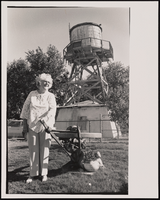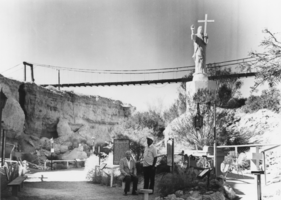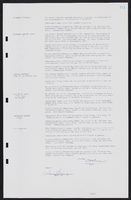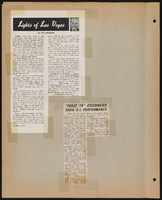Search the Special Collections and Archives Portal
Search Results

Marcelina Sandusky standing in backyard located within the original Sunrise Acres community with the water tower visible in the background: photographic print
Date
Archival Collection
Description
Around the turn of the century, Ramon Sanchez emigrated from Spain to the United States where he became a rancher in Tremonita, New Mexico. Many years later, his son, Cesario, migrated to Liberal, Kansas, to work on the railroad. It was there that his daughter, Marcelina, pictured above, was born and raised and where she eventually met and married her musician husband, Gene Sandusky. In 1941, the Sanduskys moved to Las Vegas where they settled in a new housing tract called Sunrise Acres. Some 45 years later, Mrs. Sandusky stands in her back yard with the original Sunrise Acres community well and water tower looming prominently in the background. Presently, Mrs. Sandusky is working hard to gather the history of that still cohesive neighborhood, one of the earliest in Las Vegas.
Image
James H. Down Jr. Photograph Collection
Identifier
Abstract
The James H. Down Jr. Photograph Collection (approximately 1915-1940) consists of black-and-white photographic prints and negatives, as well as color photographic slides and postcards. The images depict scenes in and around Las Vegas and Goodsprings, Nevada. Also included are Glenn Davis' photographs of the Hoover Dam (Boulder Dam), Black Canyon, the Colorado River, and Lake Mead. Most of the images portray the construction phases of the Hoover Dam.
Archival Collection
Charles P. Squires Photograph Collection
Identifier
Abstract
The Squires Family Photographs document the Squires Family and the development of the Las Vegas Valley in Nevada from approximately 1860 to 1980, with a bulk of the photographs depicting people and events from 1900 to 1950. The photographs depict the Euro-American settlement and growth of Las Vegas, Nevada; traveling and exploration of Southern Nevada and the Southwestern United States; the Hoover (Boulder) Dam and the Colorado River; clubs and social groups; and the Squires Family, especially prominent newspaper editor and publisher Charles Pember (C. P. or “Pop”) Squires, Delphine “Mom” Anderson Squires, and their children.
Archival Collection

Transcript of interview with Theodore R. Garrett by Marilyn Swanson, March 2, 1975
Date
Archival Collection
Description
On March 2, 1975, Marilyn Swanson interviewed Theodore R. Garrett (born 1898 in Overbrook, Kansas) about his life in Boulder City, Nevada. Garrett first talks about his move to Las Vegas to work for Six Companies during the construction of Hoover Dam. He then describes his job as a truck driver at the dam, the wages paid at the time, and the construction of the buildings and other housing in Boulder City. Garrett also mentions the food provided to the workers, the recreational activities available, and his family’s move to Boulder City.
Text

Jose Leonardo Martinez oral history interview: transcript
Date
Archival Collection
Description
Oral history interview with Jose Leonardo Martinez conducted by Barbara Tabach and Nathalie Martinez on August 19 and 29, 2020 for the Latinx Voices of Southern Nevada Oral History Project. Session 1: Jose discusses his childhood and what it was like growing up during the Salvadoran Civil War. He recounts the dangers he's faced and how he made his way to the United States after traveling through Guatemala and Mexico. Subjects discussed include: Salvadoran Civil War; Ciudad Arce, El Salvador; Guatemala; Mexico; Los Angeles, California. Session 2: Jose continues his discussion of growing up in El Salvador and the violence he witnessed in the country's army during the 1980s. He also talks about his personal life after moving to the United States and his experiences navigating gang culture in Los Angeles, California. Jose recounts his previous jobs, his schooling, how he met his wife, and his family's move to Las Vegas. Subjects discussed include: El Salvador army; gang violence.
Text

Suspension bridge and the statue of Christ at Cathedral Canyon, Nevada: photographic print
Date
Archival Collection
Description
From the Nye County, Nevada Photograph Collection (PH-00221) -- Series IV. Pahrump, Nevada -- Subseries IV.D. Wiley Family. The statue, carved of rock, is a small replica of the Christ of the Andes installed in the Andes Mountains on the border between Argentina and Chile in the early part of the 20th century. The replica was made by a sculptor named Jose Ramos from Ajijic, a small town south of Guadalajara, Mexico. Wiley constructed the suspension bridge about 1973. In 1989, approximately 1,000 a month visited Cathedral Canyon. Roland Wiley and unidentified person (identified from left to right).
Image



